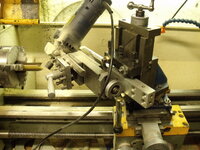This is the one that was suggested...
G9972Z 11" x 26" Bench Lathe w/ Gearbox
How difficult would it be to create the curves and bulges that I like with a metal lathe?
Shawn; Metal lathes are intended to turn objects round and exactly to size, but, curves aren't part of their normal makeup. You can make a tool rest and use a normal wood lathe tool as others have mentioned.
As far as this particular lathe is concerned, it appears to be a 9x20 enlarged and on steroids. The 9x20 lathe I have has a number of design limitations. These comments apply to the 9x20, and *MAY* apply to this lathe also. Notice I said may the designers may have addressed the limits of the 9x20 in this larger lathe.
1. The compound 2 bolt mount isn't very rigid. Many people replace the mount with a 4 bolt or John Pitkin - Donut Mount. This is the most serious limitation of the 9x20 and is a MUST DO!
2. The tail stock lock doesn't have a handle. You need to turn a hex head bolt to move and lock the tail stock. This gets old very fast and a Cam-Lock handle makes things much easier and faster.
3. Some times you just need variable speed. There are no "drop in" variable speed packages for metal lathes. VS conversions are documented and can be done.
I hope this helps.

